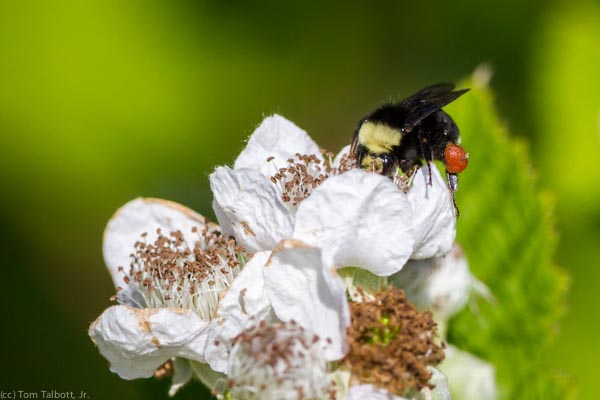Spring bumble bees
 May 5, 2016
May 5, 2016 
I was talking to my neighbor Rich the other day and he mentioned something in passing about bumble bees that I didn’t know—all of the bumble bees you see in early spring here are queens. Bumble bees live in underground colonies, consisting of a single female queen bee, female worker bees, and male drones. Most of the bees die off in the winter, but queens that have been fertilized but have not yet nested, overwinter and emerge from hibernation in the spring.
In mid- to late-March this year I had started noticing some especially big, round, furry bumble bees rattling around in the back yard. I like knowing now that they are all fat with progeny, and that they are looking for a spot to nest. I read that they sometimes nest in abandoned rodent burrows, so I have been peering into every hole I find to see if there are any bees using it. I also read that at least some bumble bees dig their own holes. Amazing to think that something the size of a piece of salt water taffy can dig a hole in the ground!
As for the bee in my backyard, I suspect now that I am seeing the same bee repeatedly. She is a yellow-faced bumble bee, with a black body and a striking yellow head. She is native, and one of the most common kinds of bumble bees in our area, so I hope to spot more like her over the coming months. Now that I am paying attention, I have also started to see some bumble bees with black heads—three of them at once were pillaging the spreading geraniums yesterday. I haven't identified what kind of bee they are yet, but now I have my eye out for them.
This all makes me realize that somehow in the last couple of years I lost sight of paying attention to the great variety of life around me. I look forward to having time on my sabbatical to remember to stop and notice. But I also don't want to wait to do this until the conditions are "just right." I think it is this kind of attitude that led to me doing less observing in the first place. So I am starting now. Today. And when I open the door to walk outside I see a stinkbug on the wall of the house. "Stinkbug" my mind says to itself. "I know what that is." But then I take a moment to actually look, and I see the angled arrowhead shape of its body, the precise black and white stripes along the edges of its back, the beautiful slate-gray of its coloring next to the purple-gray of the house. And somehow in that moment of pausing, time feels more expansive, the world feels less cramped, and the tasks of the day seem more joyful.
NOTE: To see more of Tom's loving portraits of wildlife, click here.
 Creatures
Creatures